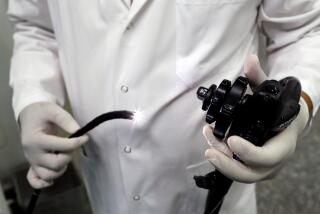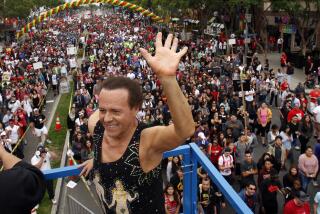Norman Breslow dies at 74; biostatistician’s work led to advances in medical research
Norman Breslow left a generation of medical researchers a lot less confounded.
The statistics whiz made “giant steps” in the math required to find risk factors for disease in ever-growing troves of medical data.
Breslow “really did lay the foundation for all modern statistical methods in epidemiology and public health,” said Ron Brookmeyer, a UCLA biostatistics professor.
Breslow, who had prostate cancer, died Dec. 9, said his wife, Gayle Breslow. He was 74.
He was the son Lester Breslow, a UCLA and California state public health leader. Norman Breslow carried on his father’s work by clearing the way for broad advances in cancer research and other medical fields.
The father, famous in his day for being “Mr. Public Health,” was born in 1915 and became an anti-smoking advocate after a bad experience with corn-cob pipes. The elder Breslow ended up popularizing what is now folksy-seeming health advice — exercise, don’t smoke, eat right, etc.
By contrast, his son was a luminary almost exclusively among fellow scholars. Though similarly influential, he followed a more technical path than his father’s.
Extremely technical. One of his papers, considered a breakout hit among fellow scientists, had this catchy title: “Approximate Inference in Generalized Linear Mixed Models.”
Very simply, it was about how to use the right math, in the right ways, to get meaningful results from disease studies.
And in an era of huge data sets and fast-expanding research into the causes and risk factors for disease, this has turned out to be a powerful thing. Breslow’s work helped open “a vast field of research,” said Brookmeyer, who credited Breslow with making “giant steps forward.”
Breslow took on nettlesome, devil-in-the-details problems that lurked in the weeds of large data sets.
His focus was to tease cause from correlation. Did factory dust cause workers’ cancer? Or was it just that they smoked? Did fewer women get cervical cancer because their pap smears worked? Or was it just that those who were tested had healthier habits?
The math Breslow perfected and formalized is the basis for what are now standard methods to filter out stray factors in so-called “case-controlled” health studies. These studies use large troves of patient case histories to figure out what led to their illnesses.
Breslow refined techniques for sifting out what doesn’t matter or what might bias results.
He was once asked by a scientific publication how he approached this research. He said he began with this thought:
“There must be a simpler way to do it.”
Breslow helped researchers in other ways too. He figured out better, more rigorous ways for calculating survival rates from disease and refined ways to make adjustments for data limitations.
His work helps countless scholars today make apples-to-apples comparisons and extrapolate from highly detailed data on small groups of subjects.
“He came along just when we got serious about dissecting out the causes of cancer,” said Jonathan Samet, chairman of Preventive Medicine at USC’s Keck School of Medicine and director of the USC Institute for Global Health. “His knack was this translation thing. He said, ‘Here is the problem, and here is the tool to help solve it.’”
Over five decades, Breslow wrote some of the most cited papers in his field — and also outside it. The “Breslow Estimator,” a standard research tool, was named in his honor, said colleague Mitchell Gail, a senior investigator with the National Cancer Institute.
Much of what is now known about causes and risk factors for cancer and other diseases was derived, in part, using his formulas.
Brookmeyer, for example, worked on the AIDS epidemic in the early 1980s, and said he and other scholars used Breslow’s work when mulling the source and potential scale of the disease.
Norman E. Breslow was born Feb. 21, 1941, in Minneapolis. His mother was Alice Philip Breslow. He grew up in the Bay Area, graduated from Berkeley High School and went to Reed College in Portland, Ore., and Stanford.
Along the way, he conducted a photo documentary project on California farmworkers and “grew up climbing in Yosemite,” his wife said. They married in 1963.
As a young professor at the University of Washington, he was given a project on Wilms’ tumor, a kidney cancer that affects mostly young children. He studied the disease for the rest of his career and applied his discoveries to larger problems. “He thought always in terms of the broader picture,” his wife said.
Medical research today is more rigorous and efficient because of Breslow’s contributions, said Patrick Heagerty, biostatistics chairman at the University of Washington and Breslow’s colleague.
The volumes Breslow completed with colleague Nicholas Day at the International Agency for Research on Cancer are considered basic textbooks for medical research. Breslow, who also held a faculty position at Fred Hutchinson Cancer Research Center in Seattle, taught several leading biostatisticians working in the country today, Heagerty said.
And true to his Yosemite youth, he remained an enthusiastic hiker, trekker and backcountry mountaineer skier throughout his life, his wife said.
In addition to his wife, he is survived by daughters Lauren Basson and Sara Jo Breslow, and granddaughter Ayelet Basson, all of Seattle; and a grandson, Benjamin Basson of Boston. He is also survived by stepmother Devra Breslow of Los Angeles.
More to Read
Start your day right
Sign up for Essential California for the L.A. Times biggest news, features and recommendations in your inbox six days a week.
You may occasionally receive promotional content from the Los Angeles Times.






